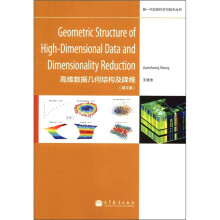Chapter 1 Introduction
1.1 0verview of Dimensionality R,eduction
1.2 High Dimension Data Acquisition
1.2.1 Collection of Images in Face Recognition
1.2.2 Handwriting Letters and Digits
1.2.3 Text Documents
1.2.4 Hyperspectral Images
1.3 Curse of the Dimensionality
1.3.1 Volume of Cubes and Spheres
1.3.2 Volume of a Thin Spherical Shell
1.3.3 Tail Probability of the Multivariate Gaussian Distributions
1.3.4 Diagonals of Cube
1.3.5 Concentration of Norms and Distances
1.4 Intrinsic and Extrinsic Dimensions
1.4.1 Intrinsic Dimension Estimation
1.4.2 Correlation Dimension
1.4.3 Capacity Dimension
1.4.4 Multiscale Estimation
1.5 0utline of the Book
1.5.1 Categories of DR Problems
1.5.2 Scope of This Book
1.5.3 0ther Topics Related to This Book
1.5.4 Artificial Surfaces for Testing DR Algorithms
Part I Data Geometry
Chapter 2 Preliminary Calculus on Manifolds
2.1 Linear Manifold
2.1.1 Subspace and Projection
2.1.2 Functions on Euclidean Spaces
2.1.3 Laplace Operator and Heat Diffusion Kernel
2.2 Differentiable Manifolds
2.2.1 Coordinate Systems and Parameterization
2.2.2 Tangent Spaces and Tangent Vectors
2.2.3 Riemannian Metrics
2.2.4 Geodesic Distance
2.3 Functions and Operators on Manifolds
2.3.1 Functions on Manifolds
2.3.2 0perators on Manifolds
Chapter 3 Geometric Structure of High-Dirnensional
3.1 Similarity and Dissimilarity of Data
3.1.1 Neighborhood Definition
3.1.2 Algorithms for Construction of Neighborhood
3.2 Graphs on Data Sets
3.2.1 Undirected Graphs
3.2.2 Directed Graphs
3.2.3 Neighborhood and Data Graphs
3.3 Spectral Analysis of Graphs
3.3.1 Laplacian of Graphs
3.3.2 Laplacian on Weighted Graphs
3.3.3 Contracting Operator on Weighted Graph
Chapter 4 Data Models and Structures of Kernels of DR
4.1 Data Models in Dimensionality Reduction
4.1.1 Input Data of First Type
4.1.2 Input Data of Second Type
4.1.3 Constraints on Output Data
4.1.4 Consistence of Data Graph
4.1.5 Robust Graph Connection Algorithm
4.2 Constructions of DR Kernels
4.2.1 DR Kernels of Linear Methods
……
Part Ⅱ Linear Dimensionality reduction
Part Ⅲ Nonlinear Dimensionality Reduction
Many objects in our world can be electronically represented with high-dimensional data- speech signals, images, videos, electrical text documents.We often need to analyze a large amount of data and process them. However,due to the high dimension of these data, directly processing them using reg-ular systems may be too complicated and unstable to be feasible. In order toprocess high-dimensional data, dimensionality reduction technique becomescrucial. Dimensionality reduction is a method to represent high-dimensionaldata by their low-dimensional embeddings so that the low-dimensional data can be effectively used either in processing systems, or for better understand-ing. This technique has proved an important tool and has been widely used in many fields of data analysis, data mining, data visualization, and machine learning.

 缺书网
缺书网 扫码进群
扫码进群





